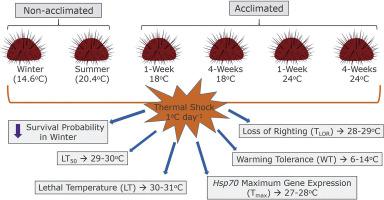Comparative Biochemistry and Physiology A: Molecular & Integrative Physiology ( IF 2.3 ) Pub Date : 2020-09-12 , DOI: 10.1016/j.cbpa.2020.110806 Natalí J Delorme 1 , Emily J Frost 2 , Mary A Sewell 2

|
Seawater temperature is projected to increase globally due to climate change, affecting physiological responses, fitness and survival of marine organisms. Thermal tolerance studies are critical to determine the ability of animals to adapt to future environmental conditions. In this study, we aimed to determine if the thermal limits of the New Zealand Evechinus chloroticus would shift with animal's thermal history. We tested the effect of six thermal regimes on the righting ability, temperature of loss of righting (TLOR), median lethal temperature (LT50), lethal temperature (LT) and the gene expression of the heat shock protein 70 (hsp70) of the New Zealand sea urchin E. chloroticus when exposed to a thermal shock of 1 °C day−1 (duration of 7–16 days depending on the treatment). Treatments consisted of laboratory acclimation for one and four weeks to 18 °C and 24 °C (mean winter (15 °C) and summer temperature (21 °C) + 3 °C of warming, respectively), compared to non-acclimated sea urchins collected during winter (14.6 °C) and summer seasons (20.4 °C). Thermal history did not have a significant effect on the righting ability of E. chloroticus (TLOR ranged between 28 and 29 °C for all treatments) and LT50 (ranged between 29 and 30 °C for all treatments). However, LT of E. chloroticus collected during winter season was significantly lower than animals acclimated for one week at 18 °C. Maximum expression of hsp70 mRNA (Tmax) was observed at around 27–28 °C regardless of treatment; however, relative hsp70 mRNA levels were significantly higher in animals acclimated for four weeks at 24 °C. Despite proving to be a thermotolerant species with LTs around 30 °C, E. chloroticus was unable to increase thermal tolerance and Tmax when acclimated to high temperatures, suggesting that E. chloroticus may have a limited adaptive capacity to modify its phenotype; however, evolutionary adaptations may allow E. chloroticus to adapt to future ocean temperatures.
中文翻译:

驯化对新西兰海胆Evechinus chloroticus的热极限和hsp70基因表达的影响。
由于气候变化,海水温度预计将在全球范围内升高,从而影响海洋生物的生理反应,适应性和生存。热耐受性研究对于确定动物适应未来环境条件的能力至关重要。在这项研究中,我们旨在确定新西兰绿螯虾的热极限是否会随动物的热史而变化。我们测试了六个热态对扶正能力,扶正丧失温度(T LOR),中位致死温度(LT 50),致死温度(LT)和热休克蛋白70(hsp70)基因表达的影响。新西兰海胆E. chloroticus当暴露于1°C -1天的热冲击下(持续7到16天,取决于治疗)。处理包括与未适应海相比,实验室适应环境分别适应18°C和24°C(分别为冬季(15°C)和夏季温度(21°C)+ 3°C的温度)一到四个星期。在冬季(14.6°C)和夏季(20.4°C)收集的海胆。热病史对绿脓杆菌(所有处理的TLOR范围在28至29℃之间)和LT 50(所有处理的范围在29至30℃之间)的扶正能力没有显着影响。然而,冬季收集到的绿叶肠杆菌的LT明显低于在18°C适应一周的动物Ç。无论处理如何,在约27–28°C时均可观察到hsp70 mRNA的最大表达(T max)。然而,在24°C适应四周的动物中,相对hsp70 mRNA的水平明显更高。尽管事实证明LTs在30°C左右具有耐热性,但在高温条件下,绿脓杆菌仍无法提高其耐热性和T max,这表明绿螯虾修改其表型的适应能力可能有限;然而,进化适应可能使绿叶大肠杆菌适应未来的海洋温度。


























 京公网安备 11010802027423号
京公网安备 11010802027423号